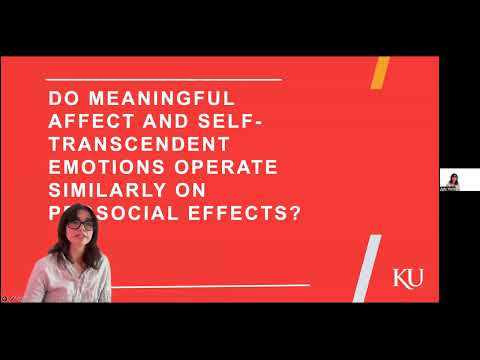 Speaker: Judy Watts @judy.watts
Speaker: Judy Watts @judy.watts
 Affiliation: University of Kansas
Affiliation: University of Kansas
 Co-authors: Jun Pei (University of Kansas)
Co-authors: Jun Pei (University of Kansas)
Title: This Really Happened: Investigating Emotional Responses to Nonfictional Eudaimonic Narratives of Opioid Use Disorder
Short Abstract: The research aims to investigate whether fictional or nonfictional eudaimonic narratives are more effective in inducing emotional responses in the audience, specifically self-transcendence and meaningful affect. It proposes that nonfictional narratives like documentaries may be more potent at eliciting emotional responses, which is crucial for learning and persuasive processes, compared to fictional entertainment narratives. The study will use videos about opioid addiction, a prevalent issue in the US, to explore the effects of narrative format (fiction vs. nonfiction) and narrative structure (redemption vs. cautionary tale) on story-consistent emotions, authenticity, and perceived learning.

 Long abstract
Long abstract
Stories that motivate audiences to adopt prosocial attitudes or behaviors have been central to several theories (e.g., EELM, Slater & Rouner, 2002; EORM, Moyer-Gusé, 2008). Theories like the EELM and EORM, respectively, identified mechanisms for which attitude and behavior change occurred, advancing understanding of how narratives successfully persuade individuals. More recently, scholars have posited that certain emotions, rooted in positive psychology (Oliver & Bartsch, 2010), are uniquely capable of eliciting reflection and mixed affect, rendering a media experience that may also result in prosocial attitudes and behaviors.
In the political realm, stories are also expected to pique interest in political topics that individuals may otherwise avoid or disregard. For instance, Bartsch and Schneider (2014) examined the effect of eudaimonic films on interest in reading newspaper articles. Schneider and colleagues (2021) proposed a dual process model for entertainment narratives; the scholars posited that hedonic and eudaimonic narrative experiences differ in their ability to garner audience interest in political topics. Specifically, Scheider et al. (2021) propose that eudaimonic (rather than hedonic) entertainment encourages audiences to reflect on socially relevant topics because of moving, realistic portrayals within the entertainment narrative. Because eudaimonic depictions typically represent real-life or real-world scenarios, it is thought that eudaimonic entertainment carries an emotional weight that leads audiences to reflect on such topics. However, it remains to be seen whether fictional or nonfictional eudaimonic stories are more advantageous for eliciting emotional responses from the audience.
It could be that entertainment eudaimonic narratives disarm audiences through their psychological distance, suspension of disbelief, or other entertaining qualities. Conversely, nonfictional narratives like documentaries and testimonial narratives may be particularly potent at eliciting emotional responses, which is crucial for learning and persuasive processes. This exploratory research aims to investigate whether fictional or nonfictional eudaimonic narratives are more advantageous for inducing audience’s emotional responses across two types of eudaimonic emotions—self-transcendence and meaningful affect. In doing so, this research aims to inform assumptions of narrative persuasion theories and dual process models of entertainment that tend to focus on prototypical entertainment—eudaimonic fictional narratives—rather than eudaimonic nonfictional narratives.
An online experiment will utilize nonfiction and fiction videos that portray opioid addiction. In the United States, opioid use was one of the leading contributors to drug overdoses (NIH, n.d.). It inspired several dramatized television shows (e.g., Painkiller, Dopesick) as well as countless documentaries and testimonials of surviving family members and individuals recounting their harrowing experiences with opioid use disorder.
H1a: Exposure to the fictional narrative will result in higher story-consistent emotions relative to the nonfictional narrative.
H1b: Exposure to the nonfictional narrative will result in higher story-consistent emotions relative to the fictional narrative.
RQ1: Will there be an interaction between the fictionality of the narrative and the type of narrative structure (redemptive vs. cautionary tale) on story-consistent emotions?
H2: The indirect effect of the nonfictional narrative on story-consistent emotions will occur via authenticity.
H3: The indirect effect of the nonfictional narrative on perceived learning will occur via a) authenticity and b) story-consistent emotions in serial.
RQ2: Will familiarity with the topic (personally knowing someone with opioid use disorder) interact with any of the above relationships?
Method
Participants (n = 400) will be recruited via an undergraduate research pool and receive course credit for participating in this research. The study will employ a between-subjects, 2 (narrative format: fiction vs. nonfiction) by 2 (narrative structure: redemption vs. cautionary tale) factorial design. Participants will respond to a pretest questionnaire before exposure to their video to collect baseline attitudes and issue interest. Then, participants will watch a short video from one of the four conditions. Finally, participants will respond to a post-test questionnaire to self-report their emotional responses (i.e., self-transcendence, meaningful affect), authenticity, perceived learning, and other outcome measures.
Conclusion
While media research has unearthed that narratives are particularly compelling for changing attitudes and behaviors for counter-attitudinal individuals and eudaimonic narratives are better at evoking empathy and similarly related emotions, very little research has dedicated itself to investigating the effect of fictionality on evoked emotions. Clarifying if and whether certain types of narratives (i.e., fictional vs. nonfiction narratives) are better at eliciting these emotions, under what circumstances, and for whom will help clarify theoretical assumptions embedded in narrative persuasion.
References
Bartsch, A., & Schneider, F. M. (2014). Entertainment and politics revisited: How non-escapist forms of entertainment can stimulate political interest and information seeking. Journal of Communication, 64(3), 369-396. https://doi.org/10.1111/jcom.12095
Moyer-Gusé, E. (2008). Toward a theory of entertainment persuasion: Explaining the persuasive effects of entertainment-education messages. Communication theory, 18(3), 407-425. https://doi.org/10.1111/j.1468-2885.2008.00328.x
National Institute of Health (n.d.). Drug overdose deaths: Facts and figures. Drug Overdose Deaths: Facts and Figures | National Institute on Drug Abuse (NIDA)
Oliver, M. B., & Bartsch, A. (2010). Appreciation as audience response: Exploring entertainment gratifications beyond hedonism. Human communication research, 36(1), 53-81. https://doi.org/10.1111/j.14682D2958.2009.01368.x
Schneider, F. M., Bartsch, A., & Leonhard, L. (2021). An extended dual-process model of entertainment effects on political information processing and engagement. In P. Vorderer & C. Klimmt (Eds.), The Oxford handbook of entertainment theory (pp. 537–557). Oxford University Press.
Slater, M. D., & Rouner, D. (2002). Entertainment—education and elaboration likelihood: Understanding the processing of narrative persuasion. Communication theory, 12(2), 173-191. https://doi.org/10.1111/j.1468-2885.2002.tb00265.x

